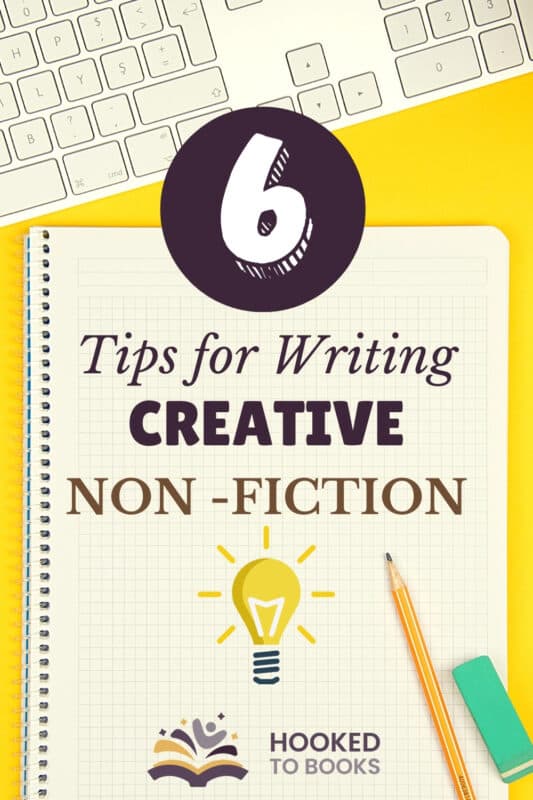What’s the first thing that comes to mind when someone says non-fiction? For me, my mind automatically considers biographies and technical books filled with scientific knowledge, which is way beyond my capabilities to grasp.
With non-fiction, it’s a genre that I’ve tended to stay away from the fear that I wouldn’t be able to enjoy or understand any of the books within it.

However, recently I’ve begun to delve into the world that is non-fiction and can see vast opportunities that it presents.
Admittedly, it still contained science-based works that I may not ever be able to comprehend. Still, there are also memoirs, cookbooks, historical reference, true crime, guides to becoming more environmentally friendly and minimalistic.
Actually, I found there was more than I would have ever expected. And there is also creative non-fiction.
What is Creative Non-fiction?
Creative non-fiction is a form of non-fiction that takes elements of literary forms often found in fiction and blends them together with non-fiction. Now, these can often be an author’s way of portraying their own personal experiences but it can be used when telling stories of other events that although the author hasn’t experienced personally, they have thoroughly researched.
Researching well into their subject matter is imperative for creative non-fiction writers. Although creative non-fiction challenges the boundaries concerning traditional methods of non-fiction, it doesn’t stray from the facts.
So, have you ever wanted to tell the story of something that happened in your own life, or retell an event’s story that has always interested you?
Ever pondered on what twists or spins that you could add while still holding to the truth? Or have you already attempted creative non-fiction but sort of lost on how to continue?
We have compiled a list of the best six tips to writing creative non-fiction successfully that we’re going to share with you to help get you started writing creative non-fiction for yourself!
Tips for Writing Creative Non-Fiction
1. Read, Read and Read

Just like the saying, you are what you eat, and this can easily be applied to writing too, as you are what you read.
Reading is one of the most fundamental elements that contribute to you becoming a good writer, whether you are writing fiction or non-fiction, fantasy or a memoir or even if you’re writing children or adult fiction. It’s important to read as much as you can.
Although this isn’t necessarily a new tip to writing creative non-fiction, reading can easily be forgotten when practicing the art of writing.
Especially when all you want to do is finish off your manuscript and have your story told and sent off to an agent in hopes of a publishing deal.
Reading is essential, especially as you are writing. Like how creative non-fiction challenges you on how you read, it also challenges you on how to approach the act of writing.
Moreover, by reading other works produced in creative non-fiction this can help give you an idea of what you like and don’t like. It will also inspire you in terms of how you will apply that to your own work.
2. Find the Story That You Wish To Tell
When writing creative non-fiction it is important to keep in mind what story you are setting out to tell. Is it something that has happened to you or you have personally witnessed or an event that happened that you were always interested in?
Figuring out what the story is that you wish to tell is paramount and should always be something you have interest in, rather than writing something else just because you think that has a better chance of being published.
Moreover, finding the right story for you to tell allows for many factors that will contribute and affect your writing to seemingly fall into place due to your genuine interest.
In writing creative non-fiction, although you are stating facts, it is important to consider several factors before writing.
Considering the overall narrative arc, what conflict will occur and what characters will feature are all factors that will become clearer once you have a story in mind that you wish to tell.
3. Reading and Research

Admittedly we have already mentioned the importance of reading as one of our essential tips to writing creative-nonfiction.
However, even though you are taking a creative spin on a factual story it is important that it remains just that, factual.
This means that through the process of writing creative non-fiction that you are going to have to do more reading and research for your story to ensure it remains truthful.
So even if you are writing about a personal experience or an event you witnessed, there will still be plenty of research for you to do.
The research may include interviewing people who were there to get their perspective and talking to experts in their fields to better understand.
The range and extent of the research required is entirely down to the story that you are writing but with creative non-fiction, it is always better to have too much research than too little.
4. Create Compelling Characters and Get In Their Heads
Like how with fiction sometimes the plot is not enough and the need for compelling characters to draw and keep the reader in till the last page is a necessary fact, this is something that applies to creative non-fiction too.
Although creative non-fiction draws upon relating actual experiences, events, facts and even real-life people, it is crucial when writing about them that they are equally compelling as their fictional counterparts.
When writing creative non-fiction the need to create and develop three dimensional and compelling characters is to ensure the readers’ interest in the story but also to encourage them to feel connected.
If your characters aren’t compelling or presented blandly, this could lead to a disconnect with your readers.
This is why it is crucial that as a writer, you get into your character’s heads, particularly if they are drawn upon real people that you intend to feature within your story.
5. Find a Group to Work With

Often writing is seen to be a lonely profession. We sit in rooms and coffee shops along with our notebooks or laptops typing out our inner thoughts and imagination onto a page.
However, when writing something like creative non-fiction often finding a group of writers to work with can not only aid with the process of writing but allows for others to comment, challenge and actively engage with your work before publication.
Working with others in this sense can be liberating for your writing. As although you as the writer know all about your story, sometimes you forget to actually state facts on the page and presume that the audience will know just as much as you.
When working with others, particularly when concerning creative non-fiction having peers point out areas of misunderstanding and communication can help you identify areas that need improvement.
Moreover, it’s a great way to bounce ideas of other writers who may even question your story’s ideas or aspects that you hadn’t thought to research yet.
6. Know Your Words and Your Responsibility as the Writer
As a writer, you should always be conscious of the fact that people will be reading your work and that your words will mean something to others.
That they will have value and influence over the people who read them, so it’s important to keep that in mind as you write.
Especially when you are writing creative non-fiction, as you are telling the story of someone’s life, experience or events that actually happened it is important that you hug the facts and remain truthful.
This is something that a lot of people forget about, especially if as you write you are hit with the brainstorm about what if this happened or that.
Although these opportunities are tempting to take, most of the time to ensure the story remains true they have to go in a notebook elsewhere to save for another time.
Remain true to your work, if you decide this is the story you want to tell, then tell it as it happened and hug those facts.
Writing creative non-fiction is exciting, it undertakes a different format to traditional non-fiction and often people read without realizing exactly what is.
It’s a form that challenges and engages with readers and writers, unlike any other form, especially as it can be applied to almost any genre too.
If you’re interested in embarking on your journey writing creative non-fiction then check out Tilar J. Mazzeo’s course, How to Write Creative Nonfiction, that includes more tips, tricks and everything you need to know about writing creative non-fiction and even a seminar on how to get it published too!



